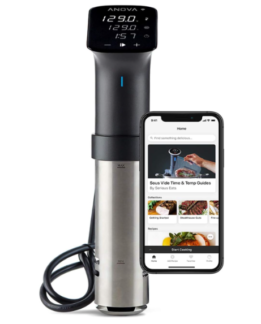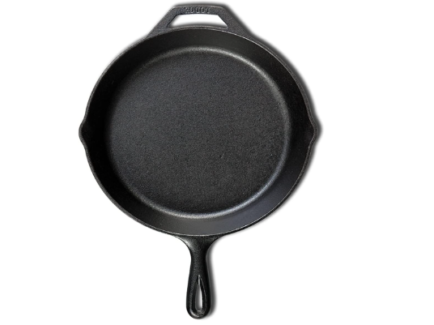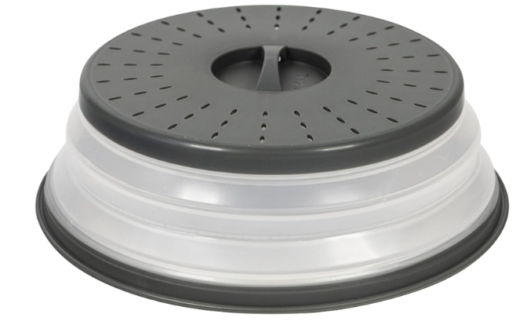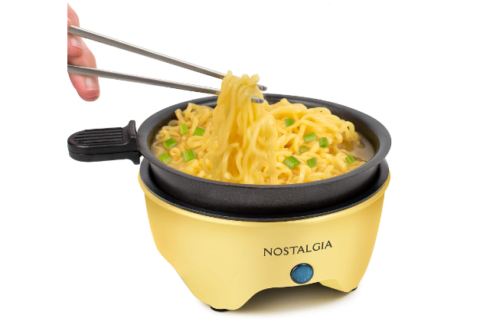A food dehydrator for herbs is a specialized appliance designed...
Read More
A food dehydrator for dog treats is a specialized appliance designed to dry and preserve homemade dog treats made from meat, fruits, and vegetables. These dehydrators typically have multiple trays and adjustable temperature controls to allow pet owners to make a variety of healthy and tasty treats for their dogs.
They provide a convenient way to create nutritious snacks for pets without the use of preservatives or other additives commonly found in store-bought dog treats.
What is the best food dehydrator for pet treats?
There are many good options for food dehydrators for pet treats on the market. Some popular brands include NESCO, Excalibur, and Presto. When choosing the best food dehydrator for pet treats, consider factors such as size, temperature range, ease of use, and durability. It is also important to choose a model that is easy to clean and maintain.
Ultimately, the best food dehydrator for pet treats will depend on your specific needs and preferences. It may be helpful to read reviews and compare features before making a purchase. Here are five food dehydrators that are popular for making pet treats:
- Excalibur 3926TB – 9 Tray Electric Food Dehydrator – this is a high-end dehydrator with nine trays, a 26-hour timer, and an adjustable thermostat. It is known for its even heat distribution and quiet operation. Full Review here
- Nesco FD-75A Snackmaster Pro – this is a budget-friendly option with five trays and an adjustable thermostat. It has a top-mounted fan and a 600-watt heating element for efficient drying. Full Review here
- Presto 06301 Dehydro Digital Electric Food Dehydrator – this dehydrator has a six-tray system with a digital thermostat and timer. It has a bottom-mounted fan and heating element for consistent drying and comes with two fruit roll sheets and two nonstick mesh screens. Full Review here
- Chefman 6-Tray Food Dehydrator – this dehydrator has six trays and an adjustable thermostat that ranges from 95°F to 158°F. It also has a digital display and a timer. Full Review here
- Magic Mill Food Dehydrator Machine – this dehydrator has six trays and an adjustable thermostat that ranges from 95°F to 167°F. It also has a digital display and a timer, and the trays are dishwasher safe. Full Review here
Can you use a food dehydrator for dog treats?
Yes, a food dehydrator can be used to make dog treats. In fact, it can be a very effective way to prepare healthy, all-natural treats for your furry friend. Using a food dehydrator allows you to control the ingredients and avoid harmful additives that can be found in many commercial dog treats.
Just make sure to use ingredients that are safe for dogs, and to follow proper food safety guidelines when preparing and storing the treats. It’s also a good idea to consult with your veterinarian to make sure that the treats are appropriate for your dog’s diet and any specific health conditions they may have.
Is it cheaper to dehydrate your own dog treats?
Dehydrating your own dog treats can be cheaper than buying commercial dog treats, depending on the type and quality of treats you make. While the upfront cost of a food dehydrator and ingredients may seem high, you can save money in the long run by making treats in bulk and avoiding the cost of buying pre-packaged treats.
Additionally, homemade dog treats give you more control over the ingredients and can be tailored to your dog’s specific needs and preferences. However, it’s important to note that some ingredients may be more expensive than others, and the cost savings may not be significant for all types of treats.
Are dehydrated dog treats better?
Dehydrated dog treats can have some advantages over other types of dog treats. Firstly, they often contain fewer additives and preservatives, which can be better for your dog’s health. Additionally, dehydrating food can help to retain more of its nutritional value than other processing methods, as it is not exposed to high temperatures for long periods of time.
Dehydrated dog treats can also be a good option for dogs with certain dietary restrictions or allergies, as you can control the ingredients that go into them. Overall, dehydrated dog treats can be a healthy and tasty option for your furry friend.
Which is better for dogs dehydrated or freeze-dried?
Both dehydrated and freeze-dried dog treats have their advantages and disadvantages.
Dehydrated dog treats are made by removing moisture from the food using heat and airflow. They tend to retain more of the original flavor and nutrients compared to freeze-dried treats. Dehydrated treats are usually less expensive than freeze-dried ones.
On the other hand, freeze-dried dog treats are made by freezing the food and then removing the moisture under a vacuum. This process helps to preserve the nutritional value of the food and can result in a longer shelf life. Freeze-dried treats are also less messy and can be more convenient to use than dehydrated treats.
Ultimately, the choice between dehydrated and freeze-dried treats depends on your individual needs and preferences, as well as your dog’s dietary requirements. It is important to choose high-quality treats that are appropriate for your dog’s size, age, and health condition.
What is the difference between air dried and dehydrated dog treats?
Air-dried dog treats and dehydrated dog treats are both processed to remove moisture, but the methods used are slightly different.
Air-dried treats are typically hung up or laid out in a dry, airy location for several days to slowly dry out the moisture. They are usually not exposed to high temperatures during the drying process, which helps to preserve some of the nutritional content and flavor of the ingredients. Air-drying is a slower process than dehydrating, but it can produce a more natural texture and flavor in the final product.
Dehydrated dog treats, on the other hand, are dried using heat and a fan to circulate air around the ingredients. This process is much faster than air-drying and can be done in a food dehydrator. Dehydrating typically involves higher temperatures than air-drying, which can affect the flavor and nutritional content of the ingredients. However, it is a more efficient way to remove moisture from the ingredients and can result in a longer shelf life for the final product.
Overall, both methods have their advantages and disadvantages, and the choice between air-dried and dehydrated dog treats may depend on personal preferences and the specific needs of your dog.
Does dehydrated dog food have bacteria?
It is possible for dehydrated dog food to have bacteria if it is not properly handled or stored. While the dehydration process can help to remove moisture and inhibit the growth of bacteria, it is not a complete guarantee that all bacteria will be eliminated.
It is important to follow the manufacturer’s instructions for preparation and storage, and to ensure that the food is not kept at room temperature for too long. Additionally, it is important to practice good hygiene when handling dehydrated dog food and to clean all utensils and surfaces thoroughly before and after use.
What is the best size food dehydrator for pet treats?
The best size of a food dehydrator for pet treats depends on how much you plan to make at once. If you have a small dog or only want to make a few treats at a time, a small dehydrator with 4 to 6 trays may be sufficient.
However, if you have a large dog or want to make a larger quantity of treats at once, a dehydrator with 8 to 12 trays or more may be a better option. It’s important to choose a dehydrator that allows for proper air circulation and even heat distribution to ensure that the treats are thoroughly dehydrated and safe for your pet to consume.
Benefits of using food dehydrator for pet treats
There are several benefits of using a food dehydrator for pet treats:
- Cost-effective: Making your own dehydrated pet treats can save you money compared to buying store-bought treats.
- Nutritious: Dehydrating pet treats allows you to control the ingredients and avoid additives and preservatives that may be harmful to your pet. You can also use high-quality ingredients that are beneficial to your pet’s health.
- Longer shelf-life: Dehydrated pet treats have a longer shelf-life compared to fresh treats, as the moisture content is removed, reducing the chances of bacterial growth.
- Easy storage: Dehydrated pet treats are easy to store and transport, making them convenient for on-the-go use.
- Variety: A food dehydrator allows you to make a variety of pet treats using different ingredients and flavors, giving your pet a wider range of options to choose from.
How to choose the best food dehydrator for pet treats
When choosing a food dehydrator for pet treats, consider the following factors:
- Size: Look for a dehydrator with enough space to accommodate the quantity of treats you want to make. If you plan to make larger batches, consider a dehydrator with more trays.
- Temperature Control: A dehydrator with adjustable temperature control will allow you to adjust the temperature to suit different types of ingredients and ensure that the treats are properly dehydrated without overcooking.
- Airflow: Good airflow is essential for proper dehydration. Look for a dehydrator with a fan, preferably one that is mounted at the bottom, to ensure consistent airflow throughout the unit.
- Durability: A sturdy, well-built dehydrator will last longer and be more reliable. Look for dehydrators made of high-quality materials that are built to withstand heavy use.
- Ease of Use and Cleaning: A dehydrator with easy-to-use controls and removable, dishwasher-safe trays will make the process of making and cleaning up after pet treats much easier.
- Brand Reputation: Look for a dehydrator made by a reputable brand with good customer reviews and a track record of producing high-quality products.
- Price: Food dehydrators for pet treats range in price from under $50 to over $300. Consider your budget and choose a dehydrator that fits within it while still meeting your needs.
What foods are safe to dehydrate for dogs?
There are several foods that are safe to dehydrate for dogs, including:
- Meat (chicken, beef, turkey, etc.)
- Fish (salmon, trout, etc.)
- Sweet potatoes
- Carrots
- Apples
- Bananas
- Blueberries
- Green beans
- Pumpkin
- Zucchini
It’s important to avoid using any seasonings, spices, or additives that may be harmful to dogs, such as garlic, onion, salt, and sugar. Additionally, some fruits and vegetables may not be suitable for all dogs, so it’s best to consult with a veterinarian before introducing any new treats into your dog’s diet.
What ingredients should not be in dog treats?
There are several ingredients that should be avoided in dog treats, including:
- Artificial sweeteners such as xylitol, which can be toxic to dogs
- Grapes and raisins, which can cause kidney failure in dogs
- Onions and garlic, which can cause anemia in dogs
- Chocolate, which can be toxic to dogs
- Avocado, which can cause vomiting and diarrhea in dogs
- Macadamia nuts, which can cause weakness, vomiting, and hyperthermia in dogs
- Raw or undercooked meat, which can contain harmful bacteria
- Bones that can splinter and cause choking or intestinal blockages
- High amounts of salt or sugar, which can lead to health problems in dogs.
It is important to always read the ingredient label of any dog treat before feeding it to your pet and consult with your veterinarian if you have any concerns.
How do you dehydrate dog treats at home?
Here are the general steps to dehydrate dog treats at home using a food dehydrator:
- Choose the ingredients: You can use a variety of ingredients like meat, fruits, and vegetables to make dog treats. Choose ingredients that are safe for dogs to eat and avoid using any seasoning or additives.
- Prepare the ingredients: Cut the ingredients into small, bite-sized pieces that will fit on the dehydrator trays. You can also marinate the meat in a dog-friendly broth for added flavor.
- Arrange the ingredients on the dehydrator trays: Place the ingredients in a single layer on the dehydrator trays, leaving some space between each piece to allow for airflow.
- Set the dehydrator temperature and time: Consult your dehydrator manual for the recommended temperature and time for the specific ingredients you are using. Generally, temperatures range from 130-165°F (54-74°C), and drying times can take anywhere from 6-24 hours, depending on the ingredients and the desired level of dryness.
- Check the treats periodically: Check the treats periodically to ensure that they are drying evenly and not becoming too dry or burnt. You can remove smaller pieces that are finished before the larger ones.
- Store the treats: Once the treats are completely dry, allow them to cool to room temperature before storing them in an airtight container. You can also refrigerate or freeze the treats to extend their shelf life.
Remember to always follow safe food handling practices and consult with your veterinarian if you have any concerns about the ingredients or preparation process.
How do you make high value dog treats?
High-value dog treats are usually small and flavorful, motivating dogs to perform desired behaviors during training or other activities. Here are some ways to make high-value dog treats:
- Use quality ingredients: Use high-quality ingredients that are tasty and appealing to your dog.
- Cut treats into small pieces: Cut treats into small pieces to make them easy to eat and to prevent overfeeding.
- Use aromatic ingredients: Use aromatic ingredients like garlic, liver, or cheese to make the treats more appealing to your dog.
- Use wet ingredients: Use wet ingredients like baby food, meat broth, or canned food to add flavor and moisture to the treats.
- Experiment with different recipes: Experiment with different recipes to find out what your dog likes best.
- Avoid using too much sugar or salt: Avoid using too much sugar or salt, as they can be harmful to your dog’s health.
- Use a food dehydrator: A food dehydrator can help you make healthy and delicious treats for your dog by removing moisture and preserving nutrients.
What are the longest lasting homemade dog treats?
Some of the longest lasting homemade dog treats include:
- Dehydrated meat treats: These are typically made from lean meat like chicken, beef, or turkey that has been sliced and dried in a food dehydrator or low-temperature oven.
- Homemade biscuits: Biscuits made with whole wheat flour, rolled oats, and peanut butter or pumpkin puree are easy to make and can last for a few weeks in an airtight container.
- Frozen treats: Frozen treats made from pureed fruits and vegetables or low-sodium chicken or beef broth can be frozen and stored for a few months.
- Jerky treats: Jerky made from lean meats like chicken or beef can be dehydrated in a food dehydrator or low-temperature oven and can last for a few weeks.
- Sweet potato chews: Sliced sweet potatoes can be baked in a low-temperature oven until they are chewy and can last for a few weeks in an airtight container.
How do you make homemade dog treats last longer?
Here are some ways to make homemade dog treats last longer:
- Dehydrate: You can use a food dehydrator to remove moisture from the treats, which will help them last longer. Dehydrated treats can last up to several months if stored properly.
- Store in an airtight container: Keeping the treats in an airtight container will help prevent air and moisture from getting in, which can cause the treats to spoil faster.
- Refrigerate: If the treats contain meat or dairy, refrigeration can help prolong their shelf life. Make sure to store them in an airtight container or sealed plastic bag to prevent moisture from getting in.
- Freeze: You can freeze homemade dog treats to extend their shelf life. Simply wrap them in plastic wrap or aluminum foil and store them in a freezer-safe container.
- Use preservatives: If you want to avoid using preservatives, dehydrating is a great option. However, if you choose to use them, make sure to use natural preservatives like vitamin E or rosemary extract. Always consult with your veterinarian before adding any preservatives to your dog’s treats.
How do you harden homemade dog treats?
To harden homemade dog treats, you can follow these steps:
- Bake the treats in the oven until they are fully cooked and firm. This will help to remove any excess moisture from the treats.
- Once the treats have cooled, place them in a food dehydrator to remove any remaining moisture. This will help to extend the shelf life of the treats and make them even harder.
- Store the treats in an airtight container in a cool, dry place. This will prevent them from becoming soft or stale.
It’s important to note that homemade dog treats should be free from any harmful ingredients, and you should always consult with your veterinarian before giving your dog any new treats or foods.
How long can dried dog treats last?
The shelf life of dried dog treats can vary depending on the ingredients and storage conditions. Generally, homemade dried dog treats can last for several weeks to a few months if stored properly in an airtight container in a cool, dry place.
However, if the treats are not properly dehydrated, or if they contain ingredients that can spoil easily, such as meat or dairy, they may not last as long. It is always important to monitor the treats for signs of spoilage, such as mold or a rancid smell, and discard them if they appear to be unsafe.
How long can dogs be dehydrated for?
It is important to note that “dehydration” in the context of dogs can refer to a medical emergency caused by a lack of water in the body, which can lead to serious health problems or even death. Therefore, it is crucial to ensure that dogs have access to clean water at all times and to monitor them for signs of dehydration.
Assuming that you are referring to the process of using a food dehydrator to make dog treats, the duration of dehydration depends on the type and thickness of the food being dehydrated, as well as the specific dehydrator being used. However, generally speaking, most dog treats can be dehydrated within 4-12 hours. It is important to follow the manufacturer’s instructions for the specific dehydrator being used and to check the treats periodically to ensure they are fully dehydrated but not over-dried.
How to clean food dehydrator for pet treats
To clean a food dehydrator for pet treats, follow these steps:
- Unplug the dehydrator and let it cool down completely.
- Remove the trays and any other detachable parts from the dehydrator.
- Wipe the interior of the dehydrator with a damp cloth or sponge to remove any debris or residue.
- Use a mild detergent to clean the trays and other detachable parts. You can also use a mixture of baking soda and water to clean any stubborn stains.
- Rinse the trays and parts thoroughly with water and let them air dry completely.
- Wipe the exterior of the dehydrator with a damp cloth or sponge to remove any dirt or grime.
- Once everything is dry, reassemble the dehydrator and store it in a clean, dry place until the next use.
It is important to clean the food dehydrator after each use to prevent the growth of bacteria and ensure that it works efficiently.
How to maintain food dehydrator for pet treats properly
Here are some tips for maintaining a food dehydrator for pet treats properly:
- Clean the dehydrator after every use: Always clean the trays and the interior of the dehydrator thoroughly after every use. Remove any food particles, debris, and oil that may have accumulated.
- Check the condition of the trays: Check the condition of the trays periodically to make sure they are not cracked or damaged. If any tray is damaged, replace it immediately to avoid contamination of the food.
- Store the dehydrator properly: Store the dehydrator in a cool, dry place when it’s not in use. Make sure to keep it away from moisture, heat, and direct sunlight.
- Replace the air filter: Some dehydrators have air filters that need to be replaced periodically. Check the manufacturer’s instructions to see how often the filter needs to be replaced and follow their recommendations.
- Check the heating element: Check the heating element periodically to ensure it’s functioning properly. If it’s damaged, contact the manufacturer for a replacement.
- Follow the manufacturer’s instructions: Always follow the manufacturer’s instructions for operating and maintaining your food dehydrator. This will ensure that it lasts for a long time and functions properly.
- Store the pet treats properly: Once the pet treats have been dehydrated, store them in an airtight container in a cool, dry place. This will help to extend their shelf life and prevent any contamination.
Troubleshooting about food dehydrator for pet treats
Here are some common troubleshooting tips for food dehydrators used for making pet treats:
- Uneven Drying: If you notice that some pieces of your pet treats are dry and others are still moist, it could be a sign of poor air circulation. To fix this issue, try spacing the treats out evenly on the trays, making sure that none of them are touching. You could also try rotating the trays during the drying process to ensure even drying.
- Overheating: If your dehydrator overheats or the food is getting too hot, it could be a sign that the thermostat is not working properly. In this case, it’s best to stop using the dehydrator and seek professional help to repair it.
- Sticky Treats: If your pet treats are sticking to the trays, it could be a sign that they are not completely dry. To prevent this, make sure that your treats are completely dry before storing them. You could also try lightly greasing the trays with oil to prevent sticking.
- Mold: If you notice mold on your pet treats, it could be a sign that the dehydrator was not cleaned properly. Make sure to thoroughly clean and dry the trays and other components of the dehydrator before and after each use. You could also try adding a few drops of grapefruit seed extract to the water when washing the trays, as this can help prevent mold growth. If the mold is severe, it’s best to discard the treats and start again with a clean dehydrator.
- Odor: If you notice a strange odor coming from your dehydrator, it could be a sign of bacteria growth. In this case, it’s best to stop using the dehydrator and thoroughly clean and disinfect all components before using it again.
Should yoy buy a food dehydrator for pet treats?
Whether or not to buy a food dehydrator for pet treats depends on your individual circumstances and preferences. If you regularly give your dog treats and want to ensure they are made from high-quality ingredients and without additives or preservatives, a food dehydrator can be a great investment. It also allows you to customize the treats to your dog’s preferences and dietary needs.
However, if you prefer to buy pre-made treats or don’t have the time or inclination to make your own, a food dehydrator may not be necessary for you. Ultimately, it is a personal decision based on your individual needs and circumstances.
Related Posts
Can you use a food dehydrator for mushrooms?
A food dehydrator for mushrooms is a kitchen appliance designed...
Read MoreHow to choose the best food dehydrator for jerky
A food dehydrator for jerky is an appliance designed to...
Read MoreWhy Trust Us
You will find what you are looking for at Jody's Bakery. From classic to luxury brands, you'll find both. We will help you to select appliances that fit your needs, budget and lifestyle. Whether you want to stop by to learn more — or plan to make a major purchase — we’ll treat you like family and assist you every step of the way. Shop with us today to receive friendly and experienced help along the way.





















What a well-written and thought-provoking article! It offered new perspectives and was very engaging. Im curious to hear other opinions. Feel free to visit my profile for more related content.
… [Trackback]
[…] Read More Information here to that Topic: jodysbakery.com/can-you-use-a-food-dehydrator-for-dog-treats/ […]
… [Trackback]
[…] Find More here to that Topic: jodysbakery.com/can-you-use-a-food-dehydrator-for-dog-treats/ […]
… [Trackback]
[…] Info on that Topic: jodysbakery.com/can-you-use-a-food-dehydrator-for-dog-treats/ […]
… [Trackback]
[…] Read More Information here on that Topic: jodysbakery.com/can-you-use-a-food-dehydrator-for-dog-treats/ […]
… [Trackback]
[…] Find More Info here to that Topic: jodysbakery.com/can-you-use-a-food-dehydrator-for-dog-treats/ […]
… [Trackback]
[…] Information to that Topic: jodysbakery.com/can-you-use-a-food-dehydrator-for-dog-treats/ […]
… [Trackback]
[…] Find More to that Topic: jodysbakery.com/can-you-use-a-food-dehydrator-for-dog-treats/ […]
… [Trackback]
[…] Read More on that Topic: jodysbakery.com/can-you-use-a-food-dehydrator-for-dog-treats/ […]
… [Trackback]
[…] Information on that Topic: jodysbakery.com/can-you-use-a-food-dehydrator-for-dog-treats/ […]
… [Trackback]
[…] Read More on that Topic: jodysbakery.com/can-you-use-a-food-dehydrator-for-dog-treats/ […]
… [Trackback]
[…] Here you can find 37954 additional Info on that Topic: jodysbakery.com/can-you-use-a-food-dehydrator-for-dog-treats/ […]
… [Trackback]
[…] Information to that Topic: jodysbakery.com/can-you-use-a-food-dehydrator-for-dog-treats/ […]